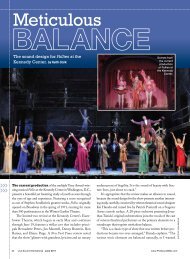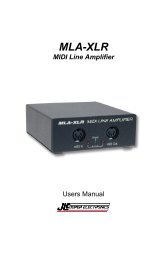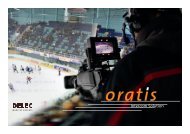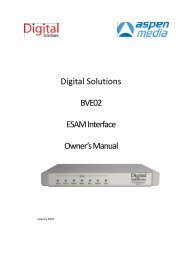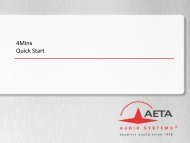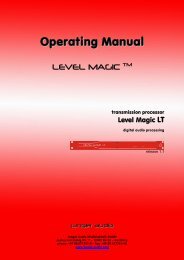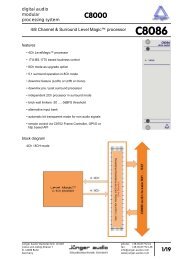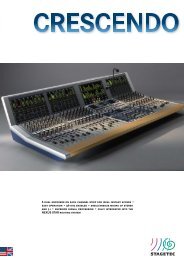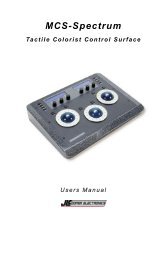Grace Design Catalogue - PDF - Aspen Media.
Grace Design Catalogue - PDF - Aspen Media.
Grace Design Catalogue - PDF - Aspen Media.
Create successful ePaper yourself
Turn your PDF publications into a flip-book with our unique Google optimized e-Paper software.
TECHNICAL DISCUSSION<br />
THE<br />
Analog<br />
Amplifier Topology - <strong>Grace</strong> <strong>Design</strong><br />
microphone preamplifiers are fully balanced,<br />
with transformerless inputs and<br />
outputs. The input amplifiers are based<br />
on monolithic, low noise instrumentation<br />
amplifiers. Gain core sections are<br />
transimpedance, or “current feedback”<br />
amplifiers, which have many important<br />
advantages over traditional “voltage<br />
feedback” op-amps.<br />
First, transimpedance amplifiers<br />
have a nearly constant bandwidth over<br />
a wide gain range and are not prone to<br />
large-signal slew rate limiting, which<br />
results in improved dynamic performance.<br />
Compared to voltage feedback<br />
op-amps (which are found in most<br />
preamplifier designs), transimpedance<br />
amplifiers have better dynamic performance<br />
and are able to track complex<br />
harmonics without adding any metallic<br />
or “solid-state” character to the sound.<br />
Also, transimpedance amplifiers reveal<br />
greater detail and provide a more open,<br />
musical sound quality. Furthermore,<br />
transimpedance amplifiers maintain the<br />
same sound quality all the way up to the<br />
highest gain levels, which makes them<br />
dramatically superior for use with low<br />
output ribbon microphones.<br />
Output Driver Stages - The<br />
balanced output stage of our preamplifiers<br />
is capable of driving extremely long<br />
cable runs and load impedances down<br />
to 50 Ohms. Transient performance is<br />
superb and is not compromised when<br />
operating in unbalanced modes.<br />
Integrated Vs. Discrete - Our gain<br />
core integrates the balanced input amplifiers<br />
on a single die and we feel that the<br />
advantages of this over a traditional “discrete”<br />
layout approach are important to<br />
understand. With the integrated amplifier<br />
components in very close proximity<br />
to each other, the paths of critical signals<br />
are kept very short. As well, energy storage<br />
from stray circuit board capacitance<br />
and inductance is eliminated. Integration<br />
of the input amplifiers also provides superior<br />
thermal tracking of input transistors<br />
and feedback resistors. It’s true that<br />
in the early days of integrated circuits,<br />
it was better to design a discrete circuit<br />
because it was not yet possible to create<br />
transistors and resistors of the same<br />
quality as discrete devices. But today the<br />
quality of integrated transistors and resistors<br />
allows integrated circuits to achieve<br />
a much higher level of sonic purity than<br />
even the best discrete designs.<br />
Misconceptions about “Class A“<br />
operation - In the early days of solid<br />
state power amplifiers, class B push-pull<br />
output stages were prone to crossover<br />
distortion, which was particularly bad<br />
sounding. By changing the operation<br />
mode to class A, designers were able to<br />
eliminate this crossover distortion, but<br />
at the expense of dramatically higher<br />
power consumption and lower available<br />
power for the speaker. But subsequent<br />
advancements in output stage topology<br />
resulted in class AB mode, which dramatically<br />
reduced crossover distortion<br />
without the power requirements of class<br />
A operation.<br />
In regards to low level electronics,<br />
such as microphone preamplifiers, class<br />
A or AB is essentially irrelevant in determining<br />
over all sound quality, as these<br />
are not power amplifiers. Modern lowlevel<br />
high speed integrated amplifiers<br />
are free from the problems of primitive<br />
solid state power amplifiers because<br />
they do not employ large geometry<br />
power transistors, and are not required<br />
to drive low impedance loudspeakers.<br />
Other design elements such as capacitor<br />
type, resistor quality, power supply<br />
grounding and circuit board layout combine<br />
to have a much greater net effect<br />
on sound quality - much more so than<br />
whether or not a design operates in class<br />
A or class AB mode.<br />
Controls - Each gain control used<br />
in all our preamplifiers (with the exception<br />
of the m802 remote controlled preamplifier)<br />
consists of a precision switch<br />
wired with 1% metal film resistors. The<br />
advantages of a fixed resistor switch over<br />
a potentiometer for gain setting are substantial:<br />
as music signal flows through<br />
a potentiometer, the potentiometer’s<br />
temperature modulates, causing its<br />
resistance to modulate. As the value of<br />
resistance changes, so does the amplifier<br />
gain, resulting in unwanted dynamic distortion.<br />
Most conductive plastic potentiometers<br />
have temperature coefficients<br />
of +/-1000ppm/ºC, which can cause<br />
considerable signal degradation at high<br />
amplifier gains. By comparison, a metal<br />
film resistor has a typical temperature<br />
coefficient of +/-50ppm/ºC, which represents<br />
more than an order of magnitude<br />
improvement in thermal stability.<br />
Relays - To keep signal paths as<br />
short as possible, relays are used to perform<br />
phase reverse, input selection and<br />
input attenuator functions. Sealed, gold<br />
contact relays offer no signal degradation<br />
and are completely reliable (rated<br />
for over 50 million operations without<br />
significant change in contact resistance).<br />
Power Supply - The power supply<br />
is the heart of any audio device. All of our<br />
products (excluding the Lunatec V3 and<br />
m101) incorporate robust linear power<br />
supplies. The IEC AC power entry module<br />
includes a power line RFI filter and<br />
provides switching for 100/120/220/230-<br />
240VAC. High efficiency, low radiated<br />
noise toroidal transformers are used for<br />
power conversion. All of the audio DC<br />
power supplies have two stages of regulation-<br />
one in the power supply and one<br />
on each audio pcb, which ensures that<br />
there is no interaction between channels.<br />
Phantom power is provided with a<br />
two-stage low-noise +48V regulator.<br />
Grounding - Correct power supply<br />
and signal grounding is a prerequisite to<br />
high fidelity audio performance. Each<br />
of our audio circuit boards incorporates<br />
a low inductance copper ground plane<br />
which provides a very stable signal and<br />
power supply reference. For added<br />
noise immunity, the 5V logic/relay and<br />
LED power supplies have their own<br />
ground returns.<br />
Passive Components - Selection<br />
of passive components is as critical as<br />
any other aspect of audio design. The<br />
quality of resistors, capacitors, inductors,<br />
connectors, wire, switches and even<br />
solder have significant effects on sonic<br />
quality. All of the passive components<br />
in our designs are selected for optimum<br />
sonic performance and long term reliability.<br />
Capacitors have the most significant<br />
impact on signal purity. The only signal<br />
path capacitors used are for phantom<br />
power de-coupling, which are ultralinear<br />
metalized film capacitors. The rest<br />
of the audio circuit is direct-coupled with<br />
DC servo control. There are no electrolytic<br />
capacitors in the signal path, which<br />
have poor temperature stability, high<br />
dielectric absorption, wide tolerances<br />
and a relatively short life span. Dielectric<br />
absorption causes a capacitor to retain a<br />
certain quantity of its charge when discharged,<br />
which then leaks out over time,<br />
causing a smearing of high frequencies,<br />
which can result in the all too common<br />
harsh, “solid state” sound quality.<br />
By contrast, film capacitors have<br />
dramatically less dielectric absorption<br />
than even the best electrolytic capacitors,<br />
which results in much improved<br />
transient performance, enhanced spatial<br />
accuracy and low frequency realism.<br />
As well, film capacitors are available in<br />
much tighter tolerances which, in the<br />
case of balanced input de-coupling, is<br />
important for acceptable low frequency<br />
common mode rejection. The use of film<br />
capacitors instead of electrolytic types<br />
results in a much more natural, less “metallic”<br />
sonic character.<br />
All audio related resistors are precision<br />
metal film types for low noise and




